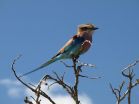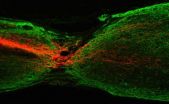(Press-News.org) Study found 35% fewer bird species in agricultural habitats
Researchers say farmland is a poor substitute for natural areas but simple improvements could make a difference to biodiversity conservation
Research led by the University of Exeter has found a substantial reduction in bird species living in cultivated mango orchards compared to natural habitats in Southern Africa. The results, which are published today in the journal Landscape Ecology, highlight the value of assessing habitats prior to land use change to predict the impact of agriculture on biodiversity.
The researchers monitored bird populations across cultivated mango orchards and natural habitats in the Kruger to Canyons Biosphere region in South Africa. They found that replacing a natural habitat with an agricultural landscape can result in a substantial decline in the richness of species living within the region.
The scientists were aiming to ascertain whether agriculture could add novel habitat elements and thereby support additional bird species complementary to those already present in the natural areas - but found that in contrast, there was a loss of 35% of the bird species within the farmed land.
One of the study's authors, Dr Frank Van Veen of the Centre for Ecology and Conservation at the University of Exeter, said: "Mango orchards are missing the low level woody scrub found in natural vegetation and the birds missing from the orchards are exactly those that have a life-style that depends on this layer of vegetation. These results show that simply measuring the vertical vegetation structure can help to predict negative effects of agriculture on biodiversity and suggest ways to mitigate these."
"This loss of richness has implications for the preservation and provision of the ecosystem, in particular pest control, seed dispersal and pollination. It is thus crucial for policy makers in countries such as South Africa, where natural habitats remain the predominant landscape features, to identify management strategies that provide the best balance between crop productivity and biodiversity conservation in the context of sustainable agriculture."
During the study, the team conducted 150 counts each at both natural habitat and mango orchard locations and measured aspects of habitat structure. Across all 300 survey points, a total of 14,278 birds representing 151 species were recorded. The results indicate that the lack of low level woody scrub in the mango orchards could account for the absence of some 26 insectivorous and nectarivorous species.
The diversity and abundance of bird species were both greater in natural habitats than in mango orchards, and whilst approximately a third of species recorded in the natural sites were unique to this habitat, there were no species unique to mango orchards.
Study author Yvette Ehlers Smith of the University of Exeter and The University of KwaZulu-Natal in South Africa added: "Our findings suggest that knowledge of habitat structure, along with species' life history traits can provide a predictive framework for effects that anthropogenic habitats may have on regional biodiversity, and allow management to reduce negative effects."
"The consequences of farmland management will have critical effects on conservation planning for biodiversity, as well as implications for food security. We recommend the inclusion of patches of natural vegetation, for example hedgerows, surrounding and within agricultural landscapes to increase habitat diversity and maintain natural levels of species richness."
INFORMATION:
'Response of avian diversity to habitat modification can be predicted from life-history traits and ecological attributes' by Yvette C. Ehlers Smith, David A. Ehlers Smith, Colleen L. Seymour, Elisa Thébault and F. J. Frank van Veen is published in the journal Landscape Ecology.
A copy of the paper can be found at: http://link.springer.com/article/10.1007%2Fs10980-015-0172-x
About the University of Exeter
The University of Exeter is a Russell Group university and in the top one percent of institutions globally. It combines world-class research with very high levels of student satisfaction. Exeter has over 19,000 students and is ranked 7th in The Times and The Sunday Times Good University Guide league table, 10th in The Complete University Guide and 9th in the Guardian University Guide 2015. In the 2014 Research Excellence Framework (REF), the University ranked 16th nationally, with 98% of its research rated as being of international quality. Exeter was The Sunday Times University of the Year 2012-13.
The University has four campuses. The Streatham and St Luke's campuses are in Exeter and there are two campuses in Cornwall, Penryn and Truro. The 2014-2015 academic year marks the 10-year anniversary of the two Cornwall campuses. In a pioneering arrangement in the UK, the Penryn Campus is jointly owned and managed with Falmouth University. At the campus, University of Exeter students can study programmes in the following areas: Animal Behaviour, Conservation Biology and Ecology, English, Environmental Science, Evolutionary Biology, Geography, Geology, History, Human Sciences, Marine Biology, Mining and Minerals Engineering, Politics and International Relations, Renewable Energy and Zoology.
The University has invested strategically to deliver more than £350 million worth of new facilities across its campuses in the past few years; including landmark new student services centres - the Forum in Exeter and The Exchange at Penryn - together with world-class new facilities for Biosciences, the Business School and the Environment and Sustainability Institute. There are plans for another £330 million of investment between now and 2016.
http://www.exeter.ac.uk/cornwall
About the University of Exeter's Centre for Ecology and Conservation (CEC)
Staff at the Centre for Ecology and Conservation, based on the Penryn Campus, undertake cutting-edge research that focusses on whole organism biology. The CEC has three interlinked research groups: Behaviour, Ecology and Conservation, and Evolution which constitute 40 academics and over 100 early career researchers. It engages widely with businesses, charities and government agencies and organisations in Cornwall, the Isles of Scilly and beyond to translate its research into societal impact. Staff at the CEC deliver educational programs to some 500 undergraduate and 100 postgraduate students.
A new £5.5 million Science and Engineering Research Support Facility (SERSF) is currently under construction at the Penryn Campus. The facility will bring pioneering business, science and engineering together and will provide space for the growing CEC alongside the University of Exeter Business School, which is expanding into Cornwall, and the University's Marine Renewables team.
The University of Exeter and Falmouth University are founding partners in the Combined Universities in Cornwall (CUC), a unique collaboration between six universities and colleges to promote regional economic regeneration through Higher Education, funded mainly by the European Union (Objective One and Convergence), the South West Regional Development Agency and the Higher Education Funding Council for England, with support from Cornwall Council.
http://biosciences.exeter.ac.uk/cec/
Wind turbines could be installed under some of the biggest bridges on the road network to produce electricity. So it is confirmed by calculations carried out by a European researchers team, that have taken a viaduct in the Canary Islands as a reference. This concept could be applied in heavily built-up territories or natural areas with new constructions limitations.
The Juncal Viaduct, in Gran Canaria, has served as a reference for Spanish and British researchers to verify that the wind blowing between the pillars on this kind of infrastructures can move wind turbines ...
Amsterdam, July 2, 2015 - Biologically active molecules released by digesting bread and pasta can survive digestion and potentially pass through the gut lining, suggests new research. The study, published in the journal of Food Research International, reveals the molecules released when real samples of bread and pasta are digested, providing new information for research into gluten sensitivity.
The research is in vitro - in the lab rather than in humans - and the authors of the study, from the University of Milan, Italy, say that more research is needed to determine what ...
With the number of individuals affected by cognitive decline expected to rise over the next few decades, investigating its potential causes is of major public health interest. Two new studies published today in the American Journal of Hypertension delve into the connection between hypertension and cognitive decline.
Racial disparity in cognitive and functional disability in hypertension and its mortality
Researchers assessed the prevalence and racial disparity of subjective cognitive and functional limitations and their impact on mortality in the hypertensive US ...
This news release is available in Japanese.
Researchers from the National Astronomical Observatory of Japan (NAOJ), the University of Tokyo and other institutions have begun a wide-area survey of the distribution of dark matter in the universe using Hyper Suprime-Cam, a new wide-field camera installed on the Subaru Telescope in Hawai'i. Initial results from observations covering an area of 2.3 square degrees on the sky toward the constellation Cancer revealed nine large concentrations of dark matter, each the mass of a galaxy cluster. Surveying how dark matter ...
The hormones testosterone and cortisol may destabilise financial markets by making traders take more risks, according to a study.
Researchers simulated the trading floor in the lab by having volunteers buy and sell assets among themselves. They measured the volunteers' natural hormone levels in one experiment and artificially raised them in another.
When given doses of either hormone, the volunteers invested more in risky assets.
The researchers think the stressful and competitive environment of financial markets may promote high levels of cortisol and testosterone ...
Researchers at the Hong Kong University of Science and Technology (HKUST) have found a way to stimulate the growth of axons, which may spell the dawn of a new beginning on chronic SCI treatments.
Chronic spinal cord injury (SCI) is a formidable hurdle that prevents a large number of injured axons from crossing the lesion, particularly the corticospinal tract (CST). Patients inflicted with SCI would often suffer a loss of mobility, paralysis, and interferes with activities of daily life dramatically. While physical therapy and rehabilitation would help the patients to ...
For a number of years now, scientific literature has questioned whether mortality rates depend on socioeconomic differences among the population. Recently, a new study carried out in 15 European cities - including Barcelona and Madrid - detected inequalities for the majority of causes, concluding that higher levels of poverty are associated with higher mortality rates and there is a great deal of variation among areas.
Social inequality is increasingly considered to be a public health problem. However, scant research has been carried out into associating these differences ...
A team comprised of scientists at VIB, KU Leuven and UZ Leuven has made significant progress in uncovering the connection between psychological factors and the immune system. Their findings are based on an investigation of a massive drinking water contamination incident in Belgium in 2010, and are now published in the leading international medical journal Gut.
In December 2010, the Belgian communities of Schelle and Hemiksem in the province of Antwerp faced an outbreak of gastroenteritis, with more than 18,000 people exposed to contaminated drinking water. During the ...
Scientists have pioneered the use of a high-powered imaging technique to picture in exquisite detail one of the central proteins of life - a cellular recycling unit with a role in many diseases.
The proteasome complex is present in all multicellular organisms, and plays a critical role in cancer by allowing cancer cells to divide rapidly.
Researchers used a technique called electron cryo-microscopy, or 'cryo-EM' - imaging samples frozen to -180oC - to show the proteasome complex in such extraordinary detail that they could view a prototype drug bound to its active sites.
The ...
This news release is available in German. Acute liver failure is a rare yet life-threatening disease for young children. It often occurs extremely rapidly, for example, when a child has a fever. Yet in around 50 percent of cases it is unclear as to why this happens. Now, a team of researchers working on an international research project headed by Technische Universität München (TUM), the Helmholtz Zentrum Munich and Heidelberg University Hospital have discovered a link between the disease and mutations in a specific gene. The researchers used whole genome ...



